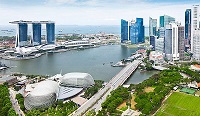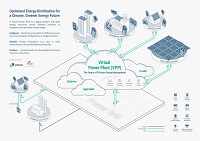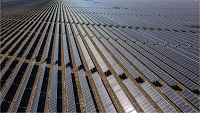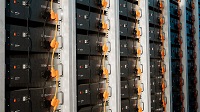Speeches
25 Oct 2023
Excellencies,
Distinguished Guests,
Ladies and Gentlemen,
- Good morning and a very warm welcome to all delegates joining us today at the Singapore International Energy Week or SIEW. I would first like to thank Clarion Events Asia for their partnership in organising the third “Future of the Grid” conference.
- Last year at SIEW, Deputy Prime Minister and Minister for Finance Lawrence Wong announced Singapore’s aspiration to achieve net zero emissions by 2050. This is anchored by the 4 switches of Natural Gas, Solar, Regional Power Grids and Low Carbon Alternatives. At this year’s SIEW, we are seeing these moves take on more concrete forms.
- We are strengthening the resilience of our natural gas supplies in the wake of the energy crisis and ensuring we have sufficient power generation capacity to meet future electricity demand.
- We crossed 1GWp of solar, and are on our way to achieving our 2030 target of 2 GWp.
- We have awarded Conditional Approvals for 4 GW of low carbon electricity by 2035 from Vietnam, Cambodia, and Indonesia.
- Low-carbon alternatives are being explored that would open more options for Singapore, such as low-carbon ammonia and geothermal.
- As announced by Minister Gan on Monday, we are taking the next steps on our pathfinder project for ammonia power generation with an RFP to select a developer for the project following our joint Expression of Interest launched jointly with the Maritime Port Authority (MPA) last year.
- Singapore has one of the most reliable electricity grids in the world. In 2022, our System Average Interruption Duration Index (SAIDI) is 0.16 minutes. Our System Average Interruption Frequency Index (SAIFI) is 0.006. Yet, we cannot take our system performance for granted. As we transit to a low-carbon future, our supply mix will gradually become more diverse with the entry of more domestic solar, electricity imports, and further out, as hydrogen displaces natural gas. Our future grid will also become more complex with increasing Distributed Energy Resources, or DERs, such as rooftop PVs, battery systems and Electric Vehicle (EV) chargers.
- The operating context for the grid will shift significantly. We need to rethink our grid planning paradigm and undertake bold and innovative initiatives to stay future-ready.
- The first imperative is to make our grid smarter and more resilient, and take advantage of advances in digital and IOT technologies.
- SP Group is developing the Digital Asset Twin in collaboration with Nanyang Technological University. Through the use of in-house engineered sensors and AI-driven analytics, the Digital Asset Twin enhances early detection of anomalies in assets. Such early detection improves grid resiliency and manpower productivity. It also allows us to get more out of our grid infrastructure assets as replacing them prematurely is costly and disruptive. SP Group targets to deploy a pilot by 2025 and expects to apply the technology to the large number of assets across SP’s 12,000 substations.
- To better manage the proliferation of small-scale Distributed Energy Resources such as Energy Storage Systems, solar and EVs across the network, SP PowerGrid will be embarking on the next phase of its pilot development for DERMS, the Distributed Energy Resource Management System. This phase will focus on improved solar forecasting and capability building to prepare for increasing EV adoption. When fully developed, DERMS will pave the way for sustainable integration of Distributed Energy Resources into the network, while managing their impact to system reliability and costs.
- We need to harness our Distributed Energy Resources and turn them into flexible assets to provide grid services while staging out grid investments in a timely way to cater to increases in demand.
- EMA has worked with S&TPPO and A*STAR to develop the “Singapore Integrated Transport and Energy Model” or SITEM. SITEM is the first high-fidelity, island-wide simulation of EV transport in Singapore. Through advanced scenario modelling and simulation, SITEM has shown how existing substation capacity could be optimised to support EV charging. This thereby avoids the need for additional electrical infrastructure. This will support the Land Transport Authority’s goal of installing 60,000 EV chargers by 2030.
- Moving beyond SITEM, A*STAR will also be developing a modelling tool as part of a multi-agency programme called the Centre for Energy and Emissions Modelling (CE2M). The tool will enable agencies to factor in future renewable energy supply and demand side flexibility to inform plans for our future net zero power grid.
- Demand management also plays an important role in the transition of our future grid. It helps create a more balanced and flexible grid by aligning electricity demand with supply. It reduces the need for costly grid expansion and contributes to a more sustainable and resilient energy system.
- We have seen other countries actively harness demand-responsive loads to contribute to grid stability. In the UK last winter, about 1.6 million households and businesses participated in a scheme where they were paid to reduce electricity use to prevent power shortages. The scheme saved over 3.3 GWh of electricity and lowered the peak electricity demand in the UK. Another example is Australia, which has awarded a contract for 120 MW of flexible demand capacity to the Western Australia energy market to balance the grid.
- Like these countries, Singapore can also unlock more innovative and flexible demand management solutions to facilitate the energy transition. This is especially pertinent as our system peak electricity demand is expected to grow at a compound annual growth rate of 3% to 5% from 2023 to 2032, due to the growth of electricity-intensive and emerging sectors.
- EMA introduced the Demand Response (DR) and Interruptible Load (IL) programmes in 2016 and 2004 respectively, targeted at larger commercial and industry customers. Both programmes benefit our power system when larger consumers reduce or defer their electricity consumption when there is less supply or more demand than expected. The DR programme allows participants to offer to reduce their demand when the wholesale electricity price crosses a certain threshold, which helps to lower system demand and wholesale electricity prices. Just last year alone, our demand flexibility resources has increased 1.5 times to around 100 MW now. We have also seen significant benefits, when just in first half of this year, DR activation allowed buyers of energy across the Singapore Wholesale Electricity Market to pay $300 million less due to reduced wholesale electricity prices. I encourage more consumers to join the programmes and contribute to demand management.
- Beyond the DR and IL programmes, we also need to extend demand management to more segments of consumers. Minister Tan announced on Tuesday that EMA will partner SP Group to launch a Residential Demand Response pilot programme, which will offer households a financial incentive to reduce electricity consumption whenever the system demand is high.
- We can also expect to see Electric Vehicles as flexibility assets in the near future. Singapore targets to have all vehicles run on cleaner energy by 2040, and some of these could participate in vehicle-to-grid (V2G) solutions. This means that the electricity stored in the EVs’ batteries could be supplied back to the grid during periods of tight supply. V2G is nascent today, with just a few commercial models of EVs capable of supporting bi-directional charging. However, it may become more developed as more EVs are adopted. It is therefore timely to kickstart our efforts to explore this emerging technology.
- I am pleased to announce that EMA and the Singapore Institute of Technology have awarded a grant to test-bed V2G technology to provide grid services. This project will allow us to understand the viability of V2G technology, and its potential for larger scale deployment to contribute to the transition of our future grid.
- According to the International Energy Agency’s recent report on Electricity Grids and Secure Energy Transitions, smarter and more resilient grids are key to countries’ transition towards net-zero emissions and accelerating the deployment of renewable energy. To that end, the role of electricity regulators is key.
- Regulators have a crucial role in ensuring that regulations and the design of the market provide consumers and industry with the right incentives and signals, so that our grid stability is maintained in the face of higher penetration of renewable energy.
- In the net-zero journey, regulators have to be forward-looking. We have to partner industry to introduce new ancillary services and market solutions needed for a “clean-energy ready grid”. For example, EMA is working with the industry to develop and test-bed a range of innovative energy storage solutions that are safer, more space-efficient, and more cost-effective. This is in preparation for the near future when energy storage systems need to be scaled up to meet intermittency management and fast response needs. We will also have to plan ahead to facilitate the entry of new green supply sources, such as having new generation planting be hydrogen-ready, as well as designing policies like an Intermittency Pricing Mechanism for DERs to recognise and allocate the costs in managing intermittency fairly.
- It is important for regulators to share our experiences and best practices to tackle this complex and important task of transforming our grids on our journey to a net-zero future. We are pleased to put together the inaugural ASEAN Energy Regulatory Forum, which will discuss pertinent issues in fostering closer collaboration in developing greener grids and enhancing regional interconnectivity. I wish to thank the regional energy regulators and experts including from ASEAN, Australia, India, Japan, United Kingdom and the United States for sharing their perspectives with us today.
- To conclude, the energy transition will be a complex journey with long-term implications on the future grid. We need to work together to build a more efficient, reliable, and sustainable energy grid that meets the needs of Singaporeans and businesses for years to come.
- I look forward to the robust discussions led by distinguished speakers on the challenges, policies, and strategies needed to transform our future grid. I wish everyone a fruitful discussion ahead.
- Thank you.















